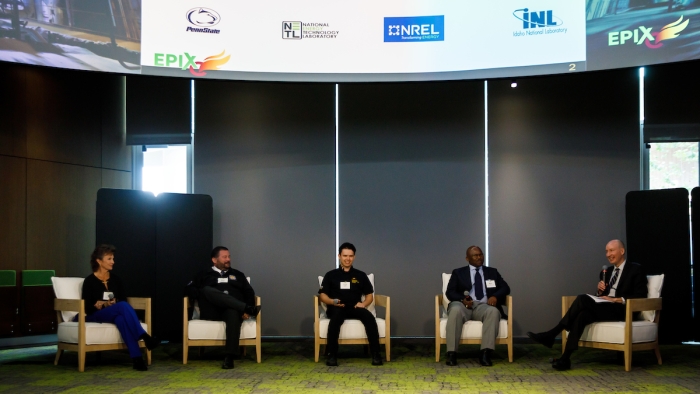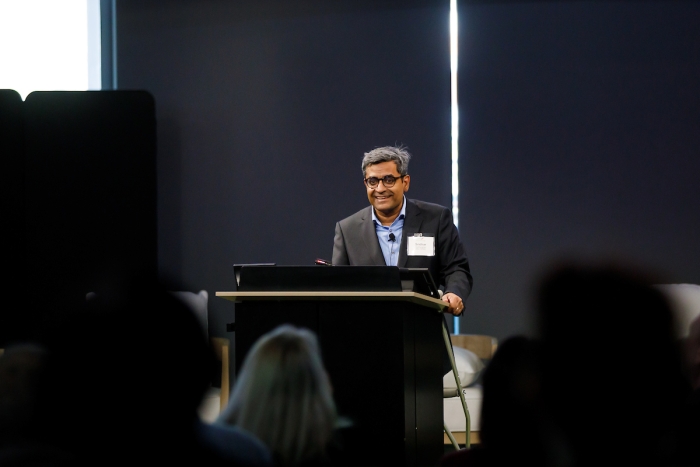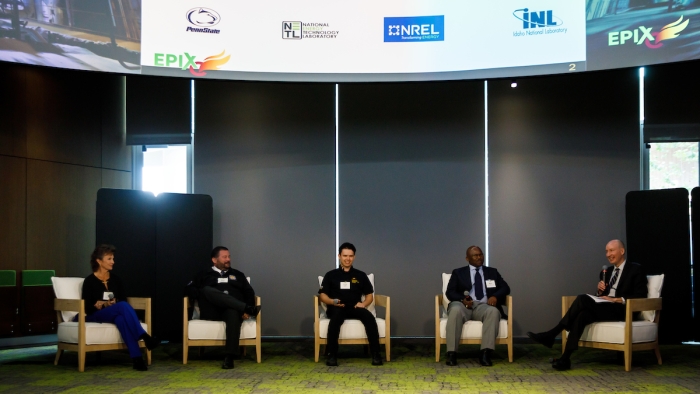
Arizona State University is at the forefront of a “clean energy revolution.”
Those were the words of U.S. Deputy Secretary of Energy David Turk at the EPIXC launch event held Thursday at the Rob and Melani Walton Center for Planetary Health on the Tempe campus.
EPIXC, which stands for Electrified Processes for Industry Without Carbon, is a multi-institution effort being led by Arizona State University, which in 2023 was chosen by the Department of Energy to receive up to devoted to the challenge of fighting greenhouse gas emissions from industrial process heating.
“This is a critical initiative,” Turk said. “It’s a big, big deal.”
Turk said greenhouse gas emissions — from pasteurizing milk to manufacturing cars to melting steel — account for one-third of the U.S. carbon footprint.
Sridhar Seetharaman, the chief executive officer for EPIXC and a professor in the Ira A. Fulton Schools of Engineering, added that the industrial sector produced approximately 10% of greenhouse gas emissions worldwide in 2020.
To put that in perspective,10% is more than the combined emissions of every plane and car in the world, said Turk.
“As our (U.S.) energy secretary (Jennifer Granholm) says, ‘Making the things we can’t live without creates (levels) of carbon pollution we can’t live with,’” Turk said. “We need to have these products. We need to have these processes. That’s a core part of what we need in our society. But we need to figure out ways to get rid of those emissions, and we have to take this head on.”
Turk said EPIXC will specifically tackle the Department of Energy’s goal to slash emissions from industrial heat by 85% or more by 2035.
“That’s a big number,” he said, “but that’s what we have to do if we’re going to be successful on climate change.”

EPIXC CEO Sridhar Seetharaman speaks at the launch event at the Rob and Melani Walton Center for Planetary Health on Thursday, Feb. 29. Photo by Andy DeLisle/ASU Knowledge Enterprise
EPIXC is operating as a public-private partnership with more than 100 companies, conducting research, development, demonstration and deployment of relevant technologies as well as workforce training.
Alongside ASU’s leadership of EPIXC, key partners include the University of Texas at Austin, Texas A&M University, Pennsylvania State University, Stanford University, Missouri University of Science and Technology, Tuskegee University, North Carolina State University, Navajo Technical University, Idaho National Laboratory, the National Energy Technology Laboratory, the National Renewable Energy Laboratory and the SLAC National Accelerator Laboratory.
In video remarks, Arizona Gov. Katie Hobbs and U.S. Sen. Mark Kelly praised ASU’s leadership in the effort to use clean energy to reduce emissions.
“The Clean Energy Manufacturing Innovation Institute will help to accelerate the clean energy transition by bringing university researchers and national labs together with private companies and labor unions,” Kelly said. “They’ll help discover and commercialize new technologies to reduce emissions from key industries. Partnerships like this are how we can turn combating climate change from a challenge to an opportunity.”
Said Hobbs: “I can’t think of a better partner in the path to a clean energy economy than ASU. And it’s clear our federal partners agree.”
Navajo Nation President Buu Nygren, who attended the launch event, said initiatives like EPIXC are vital for underserved communities.
“There’s thousands and thousands of our Navajo people, Hopi people and Indigenous people in Arizona that still don’t have access to electricity, to clean water, to be able to utilize resources like telehealth, to be able to have power and do the things that we take for granted here in the larger cities,” he said.
Seetharaman said the vision of EPIXC is to make electric heating economical and scaled to a point where it will support “decarbonization everywhere for everyone.”
Seetharaman and Turk also stressed that the electrified process has to work for the community in which a manufacturing facility is going to be located. They noted that, in the past, energy transitions, particularly in the petrochemical industries, have not been equitable.
“They were all located in districts where communities around those districts did not benefit from the economic profits, but they did get the brunt of the pollutions,” Seetharaman said. “We need to make sure that this energy transition is equitable, and EPIXC will be part of thinking about and developing solutions to do that.”
Seetharaman said that in addition to the technical goal of reducing manufacturing emissions, EPIXC hopes to train up to 3,000 people over the next five years.
That workforce development is essential, Turk said, adding that “with all the electrification that’s happening,” it’s estimated that one million more electricians will be needed by 2030.
He said he often asks audiences a rhetorical question: What is the most important fuel for a clean energy future?
“Some may say sun, especially here in Arizona,” Turk said. “But it’s not sun. It’s not wind. It’s people. We are not going to have the clean energy transition revolution that we need sustained over time unless we have more and more people getting into the profession.
“And not just scientists and researchers doing the hard technology. It’s social scientists, lawyers, entrepreneurs, people across the board to be part of this shared journey.”

U.S. Department of Energy Deputy Secretary David Turk (right) moderates the “Training a Future-Ready Manufacturing Workforce and Building Community Partnerships” panel at the EPIXC launch event on Thursday, Feb. 29. Panelists (from left) are: Leah Palmer, executive director, Arizona Advanced Manufacturing Institute; Shawn Hutchinson, training director, Phoenix Electrical JATC apprenticeship program; Joseph Elliott, student, Industrial Assessment Center; Melvin White, executive director, Golden Triangle Empowerment Center. Photo by Andy DeLisle/ASU Knowledge Enterprise
In a panel discussion of industry leaders moderated by Michael Baldea, the chief technology officer of EPIXC, Joseph deGraft-Johnson, the senior product manager for Salt River Project, said EPIXC will be a driving factor in the clean energy effort.
“This is about the ecosystem and brining everybody together. It’s about innovation, it’s about sharing information and it’s about the collaboration,” said Thomas Kwan, vice president at Schneider Electric. “With that, you see EPIXC really providing guidance to the industry and providing solutions to electrified heating.
“Showcasing those technologies at scale is really going to reduce the emissions and is critical to move the industry where we need to go.”
